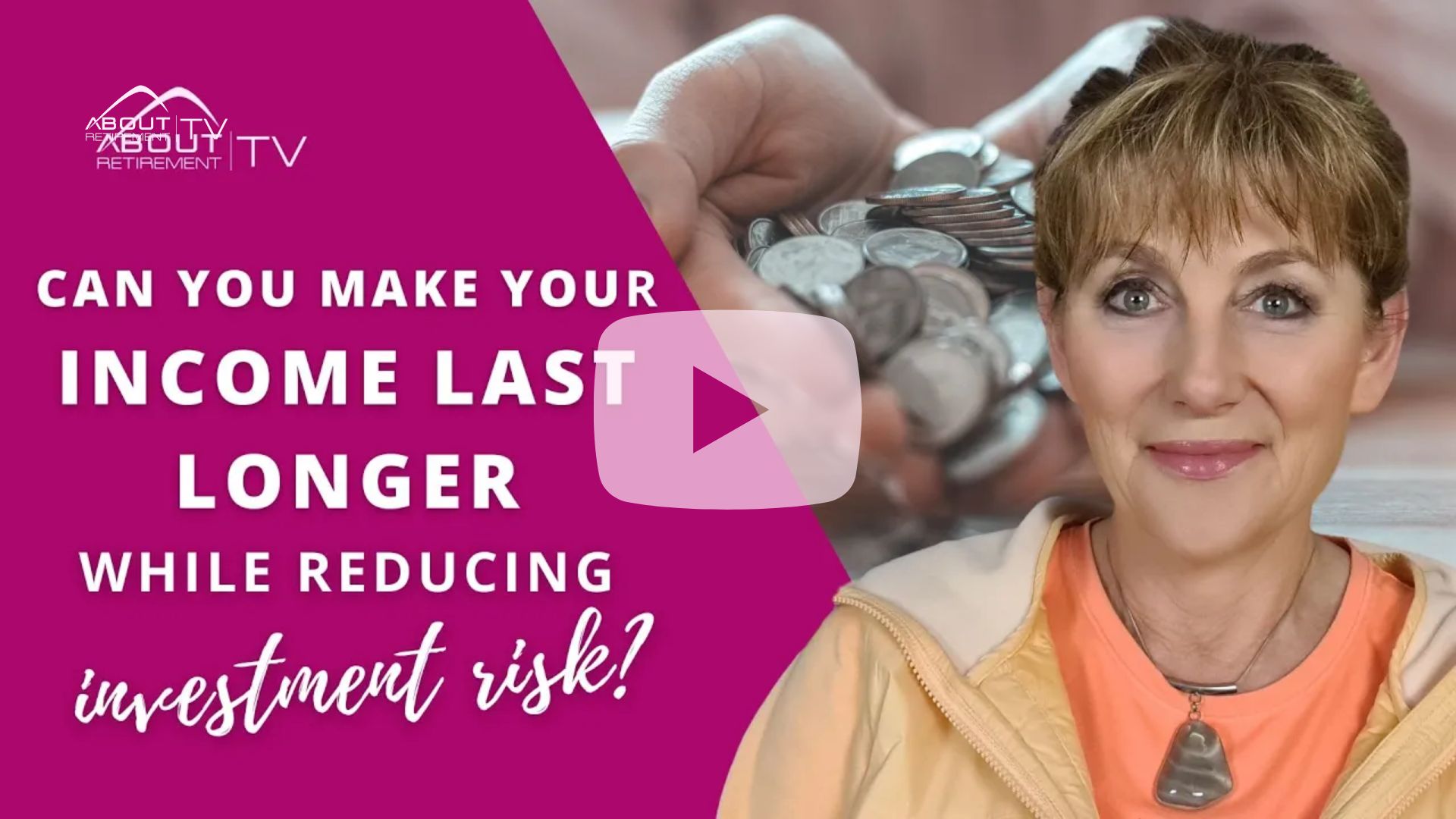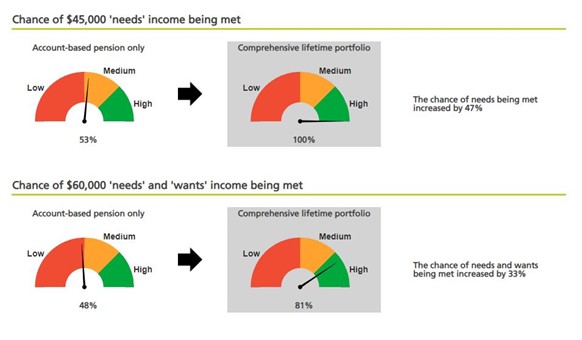
How to prolong income in retirement without taking extra investment risk
One of the most important tasks ahead of you when preparing for retirement or when already retired is to set your financial plan in such a way that you don’t overspend, but rather pre-determine what is the optimum level of income you can enjoy in retirement, so you never run out of money.
Unfortunately, most calculators provided by super funds use very generic information with not much allowance for personalisation, meaning entering data that is meaningful to you and not just based on general assumptions.
Yes, financial advice can be costly, but in reality, if advice provided to you can gives assurance that you will never run out of money, or alternatively, that your savings can be set up in such a way, that you can enjoy a higher level of income or more government benefits, I think that could be a benefit worth asking a specialist for a specific advice.
And today I want to show you what type of information you can actually receive from such expert planning, that will give you a great deal of certainty and security, therefore a real sense of peace of mind in retirement, which is basically what we all want.
So please prepare your coffee or tea and let’s go over our topic of today:
“How can you make your money last longer in retirement
without taking any additional market and investment risk?”
The most obvious thing to do would be to increase the value of your investments within the more aggressive types. We all know the saying that over a longer investment term, growth assets should outperform conservative assets, and your overall returns should be higher.
But from what I hear, many retirees are saying that they just simply do not have the time for that longer run, and high volatility of returns worries them.
So, is there any other way to improve your income for life, and how can you know that your money will support you for as long as you are going to live?
Today I will give you an example how this can be achieved, but please remember, this is an example only, and the outcome is different in every situation.
Therefore, this is not a video providing you with any personal advice, but rather I want to make you aware of possibilities, which you need to research or simply request a good, personalised advice to know the best strategy for you and your future income.
Let’s meet our today’s couple Peter & Sue. They are your typical Aussie couple getting ready to retire, but they want to make sure from the start that they do not have to worry about the level of income or running out of money.
They are ready to do some work and proper planning before they settle on any specific types of income streams in retirement.
Peter and Sue are 67 years of age. Their assets are as follows:
- Family home valued at $800,000
- $10,000 value of home contents,
- $15,000 car,
- $50,000 in Term Deposit for a rainy day,
- $350,000 in Peter’s super fund and
- $250,000 in Sue’s super fund.
The easiest way is just to blindly commence an Account Based Pension when commencing retirement, and just draw funds as needed. But how do you know if that money will really last you your lifetime? How do you know that you do not face the problem of outliving your money?
After all, statistically there is:
- 75% probability that Peter will live another 15 years in retirement and Sue will live 17 years in retirement,
- 50% probability that Peter will live 21 years and Sue 23 and
- 25% probability that Peter will live 26 years and Sue will live another 28 years.
What should be even more concerning is the fact that as a couple, at least one of them has:
- 75% chance live another 22 years
- 50% chance to live another 26 years and
- 25% chance to live another 30 years
30 years is a very long time to draw income from your savings if you no longer working and no longer supplementing your spendings with new money.
Here is the graph showing exactly the longevity calculations for Peter and Sue:

As you know, according to AFSA (Australian Financial Security Authority) a retired couple require and income of $45,000 to cover expenses of your essential needs in retirement. Anything above that amount is to cover your discretionary spending or your “wants”.
If you are not sure what I am talking about, read: “What income is needed in Retirement“
So going back to my previous statement, if you just blindly commence an Account Based Pension, how long do you think the income is going to last?
If you are not sure how this type of an income stream works, check: “Account Based Penson – good and bad explained“.
Based on just basic CPI at 2.5%, defensive investments returning 3% and growth investments 6%, that account-based pension is only going to last for Peter and Sue till the age of 95, and then there are no savings left.
Therefore, there are no savings for Aged Care and no savings left to leave behind as inheritance, apart from a family home.
So where is the income coming from?
- $18,741 is paid to Peter and Sue as a combined annual Age Pension amount
- $30,000 from Account Based Pension this is the minimum balance that needs to be paid out of the fund,
- $1,500 from interest from cash and term deposit
The worrying outcome of my calculations is that there is only 53% probability of that basic income of $45,000 being paid to them for life expectancy.
If they live 3 years longer, that probability drops down to 34% and if they are unlucky enough to live 6 years longer than expected, then there is only 21% probability that this level of income will be available to them both.
But what Peter and Sue want is to have a retirement income of $60,000pa.
Not surprisingly, there is only 48% probability of that level of income being provided to them for life expectancy, 31% if they live 3 years longer, and only 18% if they live 6 years longer than their life expectancy.

That is a very scary scenario if you ask me.
So what can be done to improve those odds of income availability for life expectancy? Do we really need to take high risk with our money to achieve longevity of our savings and our income?
On contrary, quite the opposite. Surprisingly this is where a smart mixture of different income streams comes to the rescue.
Let’s assume that instead of placing the full super savings into an Account Based Pension, we mix it with an investment into a specific type of an annuity of say $200,000.
Your odds of being provided with the basic $45,000pa income increased from 53% up to 100%, which is an increase by 47% and even the requested income of $66,000 from 48% up to 84%, increase by 33%.

So why is this happening?
- income is being increased in first year by $9,335
- there is an Age Pension increase of $5,616 in year 1 (this is an increase of 30%)
- There is a 47% increase of probability that the basic “needs” covering income will be provided 100% for life expectancy.
- There is 33% increase in probability that the requested income of $60,000 will be provided to them for life expectancy
- And, what is even more surprising, is the fact that the value of the estate is also increased by $104,719.
And all of this is being achieved by actually being more conservative and not by taking high investment risk.
And this analyser is not based on some average market returns, but rather based on over 2,000 different simulations of different past market returns over the years that provide you with highest probability you can achieve with a calculator to predict your future financial outcomes, such as:
- how long will you be provided with your chosen level of income
- the best way to structure your savings between defensive and growth assets
- income available to you, should you live longer than your life expectancy
- comparison of the value of your estate between
Obviously if you wish to increase your odds even further, it is a great idea to build your Allocated Pension portfolio accordingly to achieve some solid capital growth over time, but as you can see, even with a modest 6% return, the odds are in your favour, if you know how to structure your retirement income stream.
So if you are worried if your money will last you your lifetime, or would like to see how your savings should be structured for the best retirement outcome, don’t rely on basic calculators of average returns.
Instead, you should really have a proper portfolio illustration for your life expectancy and beyond, so you don’t have to worry about ever running out of money in your retirement.
If you would like to see how your odds stuck up with the way you have structured your retirement income, or you seek advice how to actually do it perfectly from the get go, please click on the button “Book a Meeting” on my website, and we can have a good chat for an hour to find out if you set up your savings with the optimal strategy or some changes should be implemented to improve security of your income for life.
By: Katherine Isbrandt CFP®
Money Strategist & Retirement Planner
Principal of About Retirement






